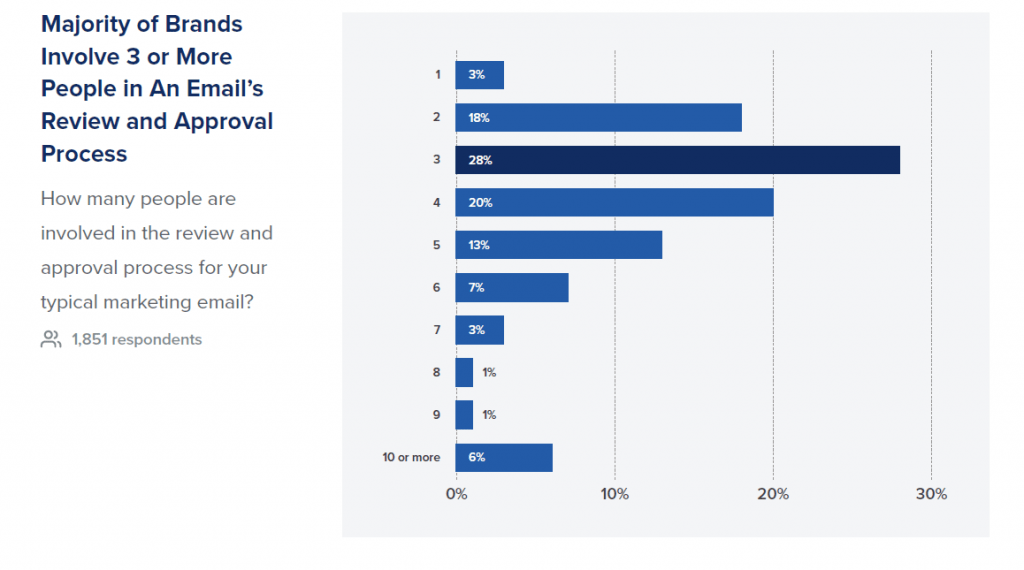#simple-text-block-block_5eed0755bb653 {
/* Add styles that use ACF values here */
}
.block-simple-text-block {
}
.block-simple-text-block.bg-texture {
position: relative;
overflow: hidden;
}
.block-simple-text-block.bg-texture:before,
.block-simple-text-block.bg-texture:after {
position: absolute;
content: ”;
background: url(‘https://www.litmus.com/wp-content/themes/litmus/dist/images/backgrounds/bg-simple-text-block-dots.png’) no-repeat center center;
height: 100%;
min-width: 102px;
}
.block-simple-text-block.bg-texture:before {
left: -2.500rem;
bottom: -4.688rem;
}
.block-simple-text-block.bg-texture:after {
right: -2.500rem;
top: -4.688rem;
}
.block-simple-text-block .row {
padding: 3.750rem 0;
}
.block-simple-text-block .copy {
/*text-align: center;*/
}
.block-simple-text-block .copy p:last-child {
margin: 0;
}
It’s rare that an email marketer works in a complete vacuum. Even an email marketing team of one needs to work with stakeholders to review campaigns, approve them, and analyze performance post-send. For freelancers—who usually work on their own—there are client emails, calls, and chats that accompany every build. In fact, email marketers work with an average of 3 other people to get an email out the door.
Collaboration can take many forms. It also frequently comes with a host of worries: new tools and processes, workflow inefficiencies, and frustration. That leads to lengthy production times for most teams, with 53% of brands spending weeks producing a campaign.
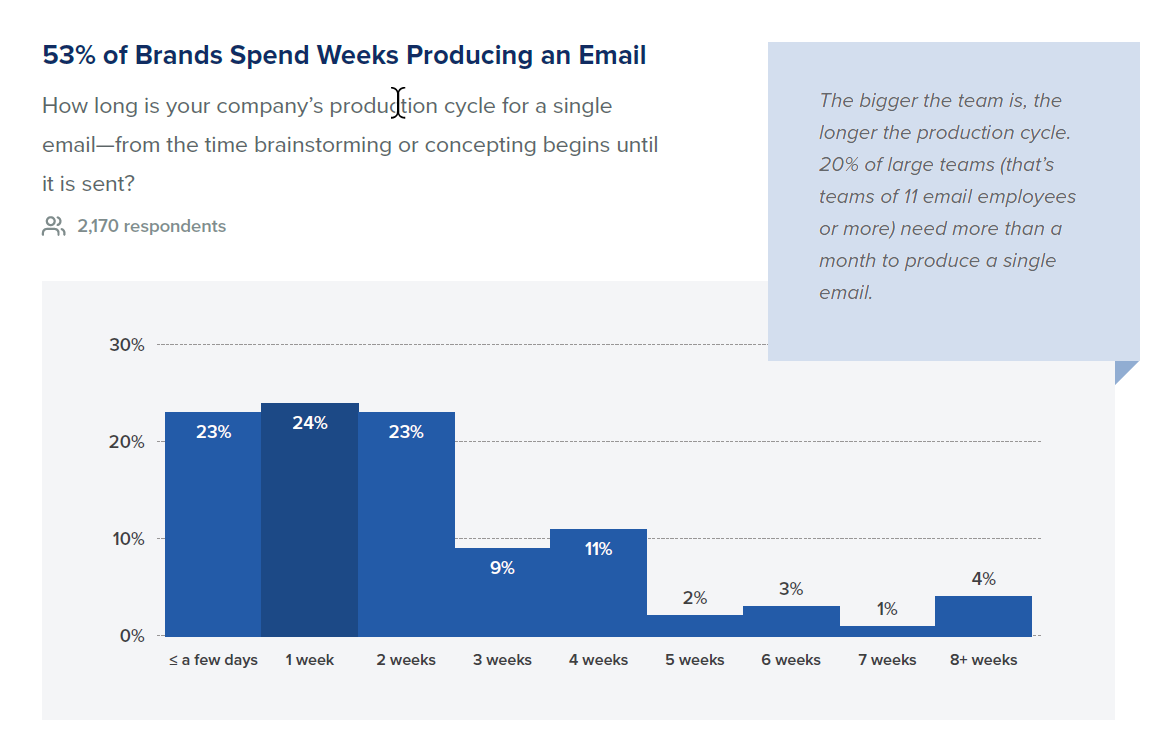
When it comes to tools, there’s no shortage of programs and services available to email marketers, but the sheer volume of tools out there is overwhelming. Resources like the Marketing Technology Landscape Supergraphic from chiefmartec.com, which lists 8,000 products available to marketers, make that abundantly clear.
At Litmus, we recognize the increasing importance of collaboration in marketing, email or otherwise. We also recognize the challenges collaboration presents. That’s why we’ve invested so heavily in making Litmus a truly collaborative platform. One that helps cut down on the number of tools a team needs, creates a more seamless experience from planning to development and QA to reporting, and removes the frustrations typically associated with collaboration in email marketing.
So, how can you use Litmus to improve email team collaboration? Oh, let me count the ways…
1. Get every member of your team involved
By definition, collaboration involves getting other people, well… involved. Our teams—and the number of other teams we work with—are growing. That’s why we’ve made it easy for users to create and manage subaccounts and teams while keeping your account safe.
Enterprise Litmus customers can quickly create new subaccounts, which are perfect for different teams, departments, or business units. Within each subaccount, you can add team members as either:
- Proof reviewers
- Reviewers
- Full users
- Admins
Check out our help guide to understanding user roles and privileges for more info on what those roles mean for your team. Don’t worry, you can keep all of their work safe through our advanced security and privacy settings. Enterprise customers have access to a wide range of security features, including two-step verification, custom session lengths, customizable password requirements, and single sign-on (SSO).
2. Speed up your review and approval process with Litmus Proof
Like everyone else in the industry, email reviews and approvals were one of the most time-consuming parts of our own email production process. We relied on a mix of instant messages, email threads, video calls, ad-hoc conversations, email test sends, and JPEGs of campaigns to make sure everything looked good before pressing send. It was… a lot.
That’s why we built Litmus Proof, a single tool for collecting feedback and approvals on email campaigns. Instead of using every communication channel under the sun to get feedback on your campaigns, you can share a Proof with your teammates, stakeholders, and clients instead.
Within Litmus, you can “push” your email from Builder to Proof, send your campaign to your own custom email address, upload your own HTML or an image of your email, or import from Dropbox, Google Drive, or Microsoft OneDrive before sharing your email with your team.
Now, instead of digging through multiple email threads or DMs, anyone on your team can click anywhere on your email and leave feedback where it should be, directly on your campaign. All of the feedback is shown as comments on your Proof, which are easy to sort through and respond to all in one place. Everything looking good? Just tap on “Approvals” and mark the campaign approved and ready to send. Need some changes? Push, upload, or email a new version to Proof and start the process with fewer headaches.
3. Quickly mention and notify team members when you need their input
One of my favorite things about Proof is the ability to mention team members in your feedback and pull them right into the conversation.
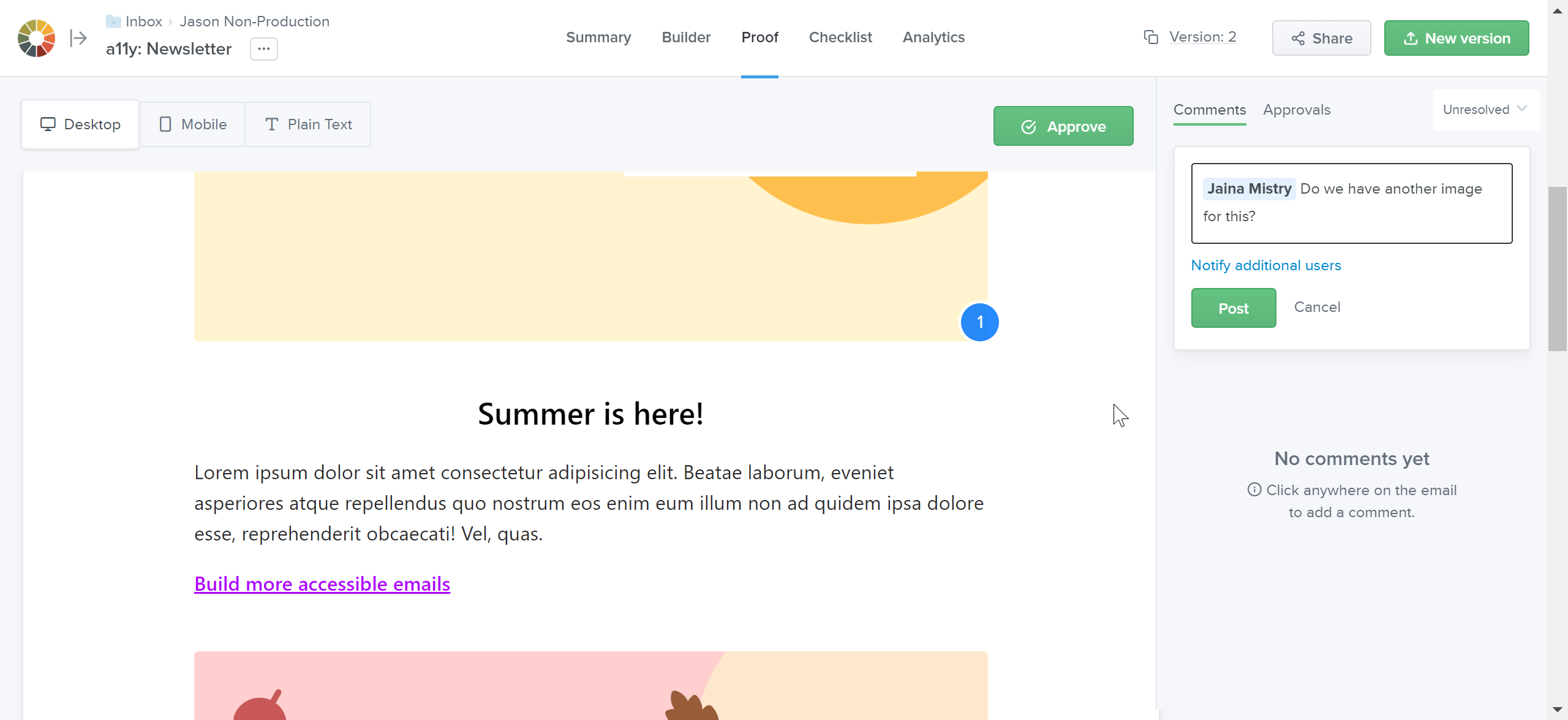
Just @ someone, the same way you would on Twitter, to notify them that you need their opinion on an email. Once you mention them in a comment, they’ll receive an email notification with a link to your Proof. And, if you have our Slack integration configured, mentions will trigger direct messages to your colleagues in Slack, allowing them to jump into your campaign as quickly as possible.
4. Integrate with other tools
Speaking of integrations, it’s easier than ever to connect Litmus with other tools in your marketing workflow. On top of our popular Slack integration mentioned above, we have a growing list of integrations with tools like Trello, Google Chrome, cloud storage providers, and some of the most popular email service providers in the industry.
With the Litmus Power-Up for Trello, you can create new emails from Trello cards or sync campaign summaries from Litmus to existing Trello cards. Now, when you’re working on campaign planning in Trello, you can keep an eye on email due dates, statuses, and open and completed tasks without having to pop into Litmus.
And, with ESP Sync, you can safely push your campaigns from Litmus to Mailchimp, Campaign Monitor, Salesforce Marketing Cloud, Oracle Eloqua, Acoustic Campaign, and Marketo—without the pain (and frequent errors) that come with copying and pasting. Once your campaign is built, reviewed, and approved in Litmus, just hit “Sync with ESP” to push the code and assets to your account for sending.
5. Collaborate with code
One of the trickiest parts of email production is the design and development phase, which is still one of the most time-consuming parts of most people’s workflows.
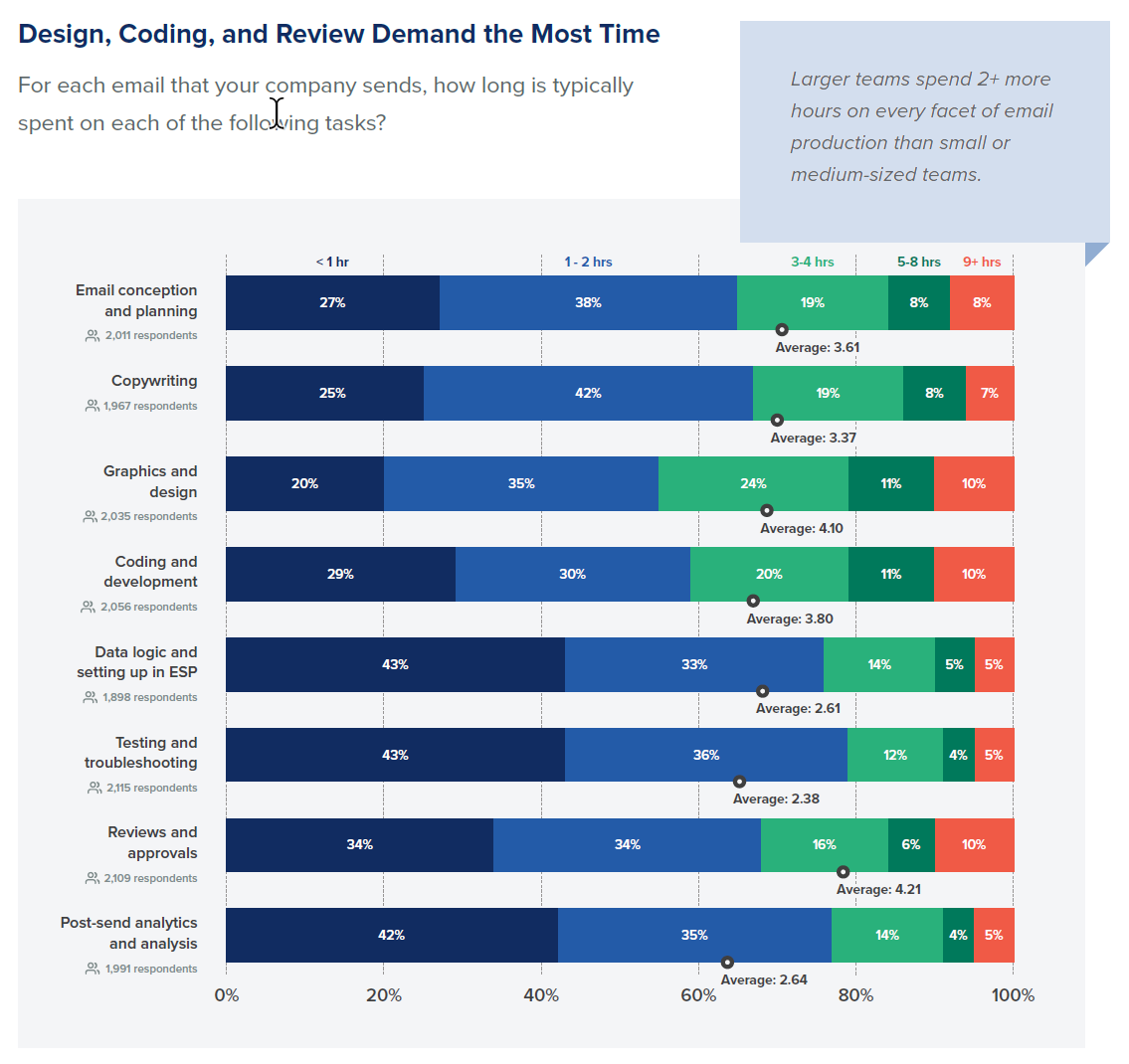
A lot of that time is spent either coding emails from scratch or copying and pasting code from past campaigns. With Design Library in Litmus, you can now have a single place for all of your templates, partials, and snippets.
Instead of copying code wholesale from past sends, you can save entire emails as templates and quickly create new campaigns from those templates. If you’re working with others, both snippets and partials help ensure that you’re working with the same underlying code. Set up snippets and partials once in Design Library; then, anyone can pull them into a campaign just by typing in include codes or expanding snippet triggers. And, in the case of partials, you can update them in one place and have those updates propagate to every campaign in Litmus that uses that partial.
6. See who made changes in Litmus Builder
When more people are involved in designing and building an email, the likelihood increases of mistakes making their way into the code. Changes to an email can often create rendering issues that are hard to diagnose and fix. In extreme cases, it’s sometimes necessary to back up and revisit older versions of your code to figure out what’s going on.
With Litmus Builder, that’s easy to do. Any time you need to see past changes to your campaign, you can click on the “Last saved…” information towards the top of Builder to open up Builder’s Timeline. Here, you can view the entire history of your email and quickly compare both the rendered email and the accompanying code, along with who made those changes and when. So, next time you get too into the weeds and need to roll back, pop open Timeline, find the version of your email you need, and click “Restore” to bring it back into your Builder project.
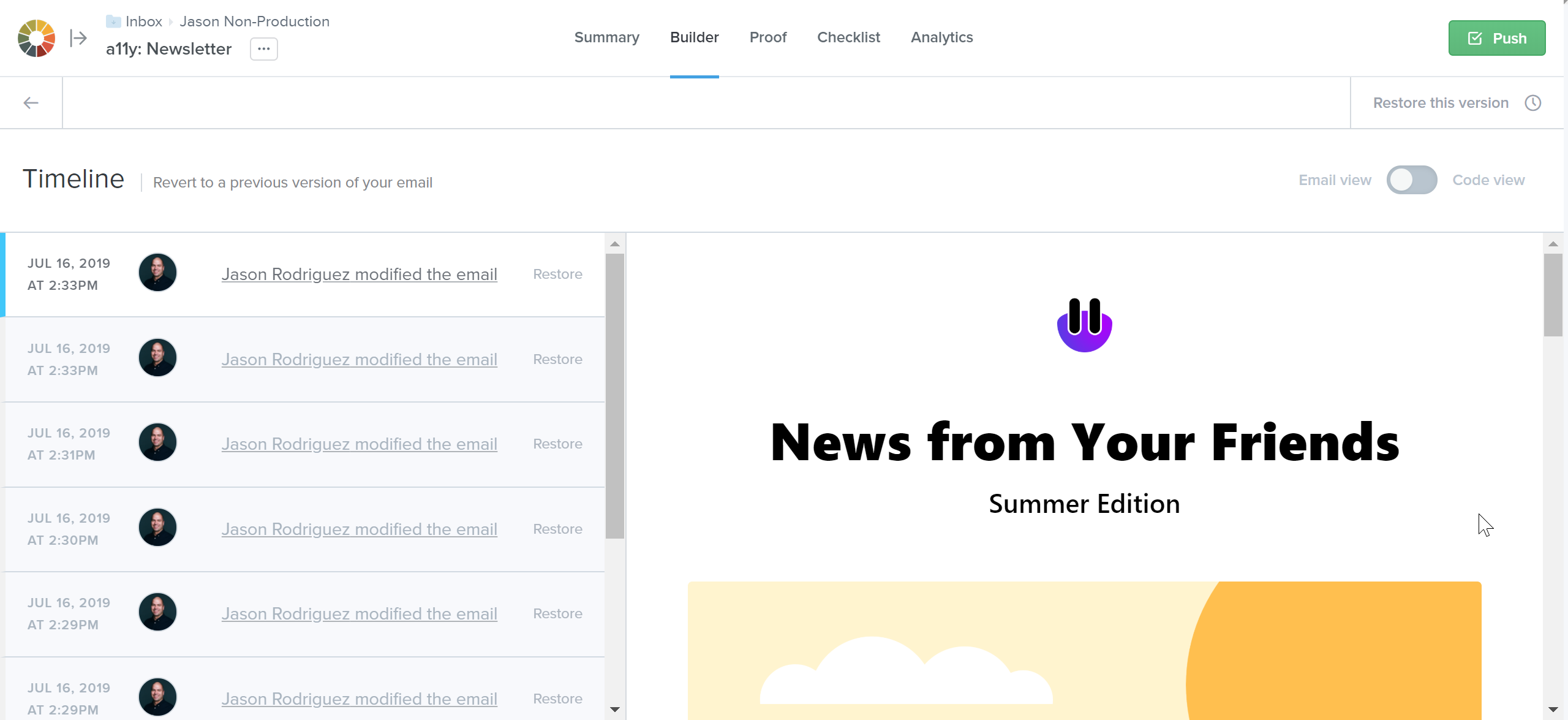
7. Get the whole picture with Campaign Summary
Finally, it’s often helpful to get and share a quick overview of an email’s status with your team. That’s where Campaign Summary comes into play.
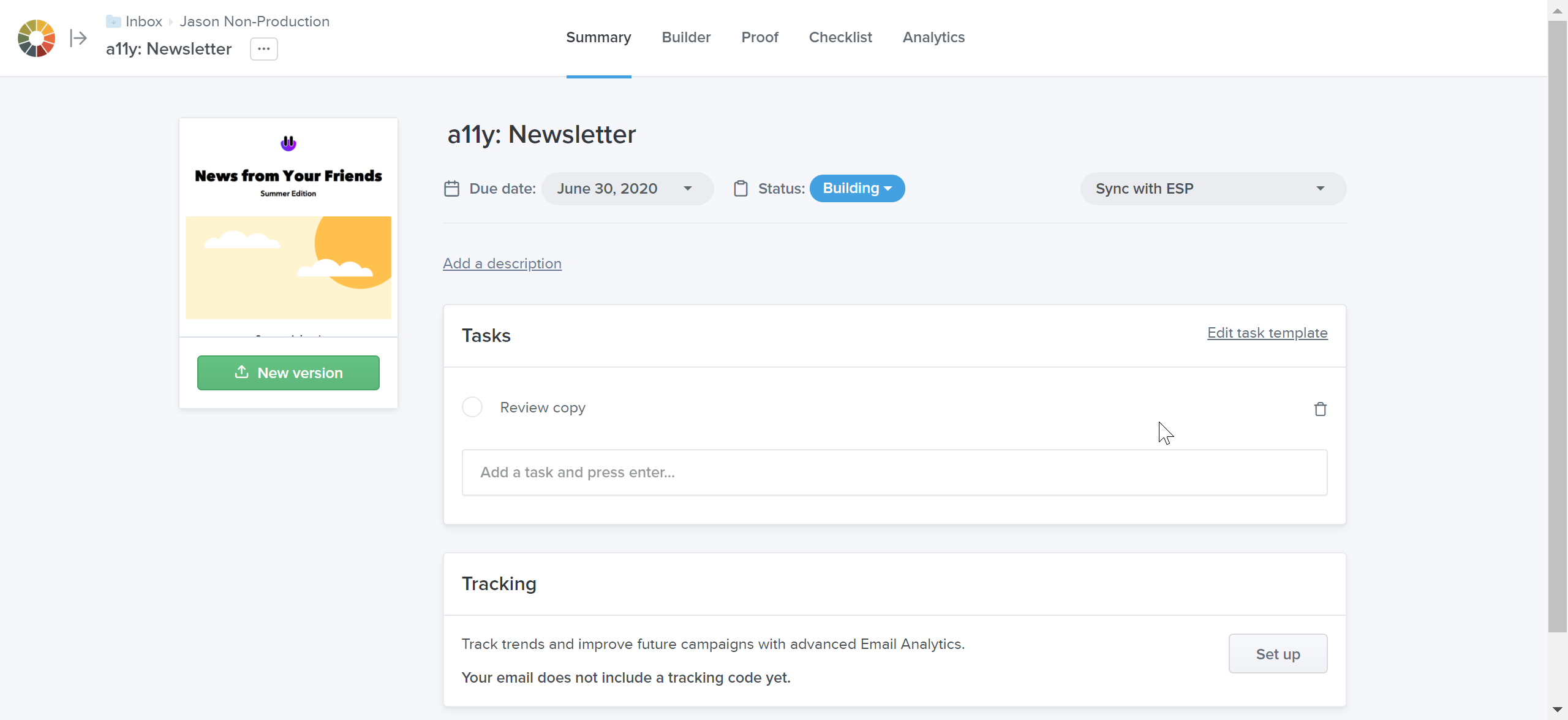
Every email campaign in Litmus provides a summary of that campaign which includes:
- The name and description of the campaign
- Due dates and statuses
- Tracking information
- Completed and outstanding tasks for that campaign
This summary is crucial for anyone that needs to track the progress of a campaign, make sure everything’s completed on time, and address any blocking issues in the process. You can set up your own custom task templates for tracking progress, assign new due dates, update the status, set up tracking, and even sync your campaign to your ESP—all from the Summary page.
And remember, if you’re using the Litmus Power-Up for Trello, all of that info is available directly in your Trello board.
Start Collaborating with Litmus Today
Collaborating with your teammates doesn’t have to be painful. Taking advantage of the features inside of Litmus can help improve your email process, keep everyone on the team up-to-date and involved, and reduce the frustration that usually accompanies collaboration. Ready to start collaborating with the power of Litmus?
Start your free trial today →
The post Looking to improve email team collaboration? Here are 7 Litmus features that make it easy. appeared first on Litmus.
